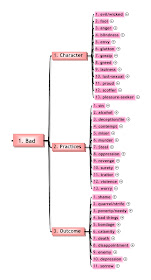The tools I used to construct the taxonomy is Mindjet mindmanager software. It is a top range mind-mapping software. I use the Text-Marker feature to create a Categories to store the tags (or keywords like love, God, evil, lie etc). Unfortunately, the text-markers only allow a linear list. I have to create my own hierarchical list for the taxonomy tree manually.
Using e-sword, I can past the entire proverb text into the mind-map of mindmanager. For every verse, I assign tags. So a verse like
- A fool despises his father's instruction, but whoever heeds reproof is prudent. Pro 15:5
The software automatically consolidate the assigned tags into a list without duplicated keywords.
I use another mindmanager software add-on ‘ResultManager” to generate another mind-map with the tags as main branches and the relevant verses as sub-branches. Hence, a tag like fool, will have all the verses assigned as fool as sub-branches. I can then study the verses on ‘fool’ and reorganize them to gain a comprehensive understanding of fool from Proverbs.
With the list of unique tags (keywords), I need to construct a taxonomy. Where can I begin? We can follow the “Facets” method of Ranganathan – which classify into 5 facets of Personality (Main Topic), Matter (the What, things), Energy (actions), Space (locations), Time (periods). This system seems to be an overkill for this proverb exercise. It could be useful for future work especially for the study of the Bible. For the time being, I choose a simple tree structure that work well with the mind-mapping software. The result is as follows:
The main tree:
The ‘Good’ branch expanded to show greater details:
The ‘Bad’ branch expanded to show more details:
And a study on ‘Fool’ is shown below:
Are we behaving like a fool? We can check the map below to see....
Here is the list of additional topic:
Will post more on the details of other key words as I study them.




Thank you for sharing your wisdom. God speed!
ReplyDelete